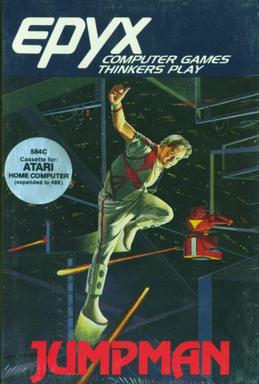
Jumpman is a platform game written by Randy Glover and published by Epyx in 1983. It was developed for the Atari 8-bit computers, and versions were also released for the Commodore 64, Apple II, and IBM PC compatibles.

Zaxxon is a scrolling shooter developed and released by Sega as an arcade video game in 1982. The player pilots a ship through heavily defended space fortresses. Japanese electronics company Ikegami Tsushinki was also involved in the game's development.

Centipede is a 1981 fixed shooter arcade video game developed and published by Atari, Inc. Designed by Dona Bailey and Ed Logg, it was one of the most commercially successful games from the golden age of arcade video games and one of the first with a significant female player base. The primary objective is to shoot all the segments of a centipede that winds down the playing field. An arcade sequel, Millipede, followed in 1982.

Frogger is a 1981 arcade action game developed by Konami and published by Sega. In North America, it was distributed by Sega/Gremlin. The object of the game is to direct five frogs to their homes by dodging traffic on a busy road, then crossing a river by jumping on floating logs and alligators.

Miner 2049er is a platform game developed for Atari 8-bit computers by Bill Hogue and released by his company, Big Five Software, in 1982. The player controls Bounty Bob through multiple levels of a mine, with the goal of traversing all of the platforms while avoiding or defeating enemy mutants. At a time when "climbing games" such as Donkey Kong had four screens, Miner 2049er had ten.

Lode Runner is a 2D puzzle-platform game, developed by Doug Smith and published by Broderbund in 1983. Its gameplay mechanics are similar to Space Panic from 1980. The player controls a character who must collect all the gold pieces in a level and get to the end while being chased by a number of enemies. It is one of the first games to include a level editor.

Choplifter is a military themed scrolling shooter developed by Dan Gorlin for the Apple II and published by Broderbund in 1982. It was ported to Atari 8-bit computers the same year and also to the VIC-20, Commodore 64, Atari 5200, ColecoVision, MSX, and Thomson computers.

Shamus is a shooter with light action-adventure game elements written by Cathryn Mataga and published by Synapse Software. The original Atari 8-bit computer version was released on disk and tape in 1982. According to Synapse co-founder Ihor Wolosenko, Shamus made the company famous by giving it a reputation for quality. "Funeral March of a Marionette", the theme song from Alfred Hitchcock Presents, plays on the title screen.
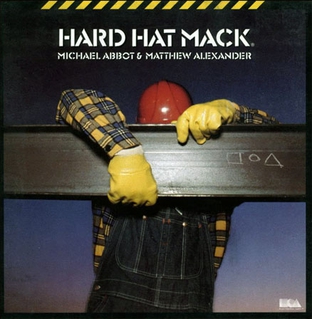
Hard Hat Mack is a platform game developed by Michael Abbot and Matthew Alexander for the Apple II which was published by Electronic Arts in 1983. Ports for the Atari 8-bit computers and Commodore 64 were released simultaneously. It is part of the first batch of five games from Electronic Arts, and the company called it out as "truly EA's first game." Versions for the Amstrad CPC and IBM PC compatibles followed in 1984.
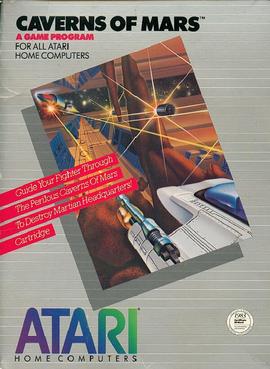
Caverns of Mars is a vertically scrolling shooter for Atari 8-bit computers. It was written by Greg Christensen, with some features later added by Richard Watts, and published by the Atari Program Exchange (APX) in 1981. Caverns of Mars became the best selling APX software of all-time and was moved into Atari, Inc.'s official product line, first on diskette, then on cartridge.

Dung Beetles is an Apple II maze game written by Bob Bishop published in 1982 by Datasoft. The gameplay is similar to Pac-Man, but a portion of the maze around the player-controlled character is enlarged as if being viewed through a square magnifying glass.

Space Panic is a 1980 arcade video game developed by Universal. Predating Nintendo's Donkey Kong, and lacking a jump mechanic, Space Panic was the first game involving climbing ladders between walkable platforms. The genre was initially labeled "climbing games", but later became known as platform games. A ColecoVision port by CBS Electronics was released in the winter holiday season of 1982.

Crossfire is a multidirectional shooter created by Jay Sullivan for the Apple II and published by On-Line Systems in 1981. Using keyboard-based twin-stick shooter controls, the player maneuvers a ship in a grid-like maze. Versions with joystick-control use the stick for movement and switch to firing mode when the button is held down.
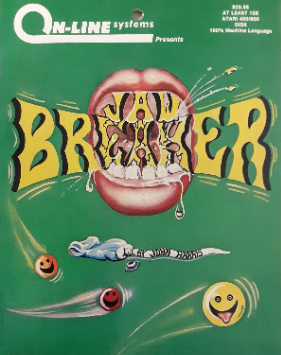
Jawbreaker is a Pac-Man clone programmed by John Harris for Atari 8-bit computers and published by On-Line Systems. Released in 1981 before an official version of Pac-Man was available, it was widely lauded by reviewers and became a major seller. The story of its creation and Harris's Atari 8-bit implementation of Frogger form a portion of Steven Levy's 1984 book, Hackers: Heroes of the Computer Revolution.

Rear Guard is a horizontally scrolling shooter written for Atari 8-bit computers and published in December 1981 by Adventure International. Neil Larimer created the game with assistance from Sparky Starks. It was ported to the Apple II, TRS-80, and TRS-80 Color Computer.
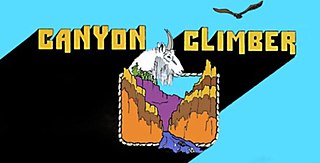
Canyon Climber is a video game designed by Steve Bjork and James Garon for the TRS-80 Color Computer and published by Tandy Corporation in 1982. Ports to other home computers were published by Datasoft. Canyon Climber is a three-screen platform game with an American Southwest theme. Two of the screens are direct analogs of those in Donkey Kong.

Mad Mines is a fixed shooter video game written for the TRS-80 by Yves Lempereur and published by Funsoft in 1982.
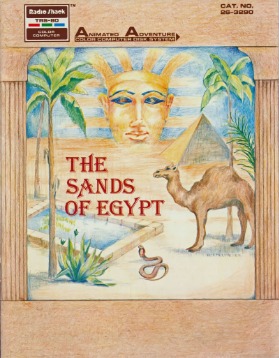
The Sands of Egypt is a 1982 graphic adventure game written by James Garon, Ralph Burris, and Steve Bjork of Datasoft for the TRS-80 Color Computer. It was licensed to Tandy Corporation and was the first disk-only game for the Color Computer sold by RadioShack. Ports to Atari 8-bit computers in 1982 and Apple II in 1983 were published by Datasoft. Set in 1893, the game follows a British explorer and archaeologist who is lost in the desert. Text commands are entered in the lower half of the screen, while a sometimes animated image of the current location is displayed in the upper half.
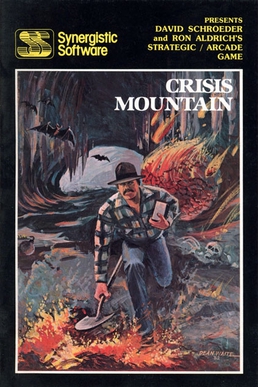
Crisis Mountain is a platform game written by David H. Schroeder for the Apple II and published by Synergistic Software in 1982. A port to Atari 8-bit computers was released in 1983. Creative Software published cartridge versions for the Commodore 64 and VIC-20. Ports for the FM-7 and PC-8800 series were from Comptiq.



















